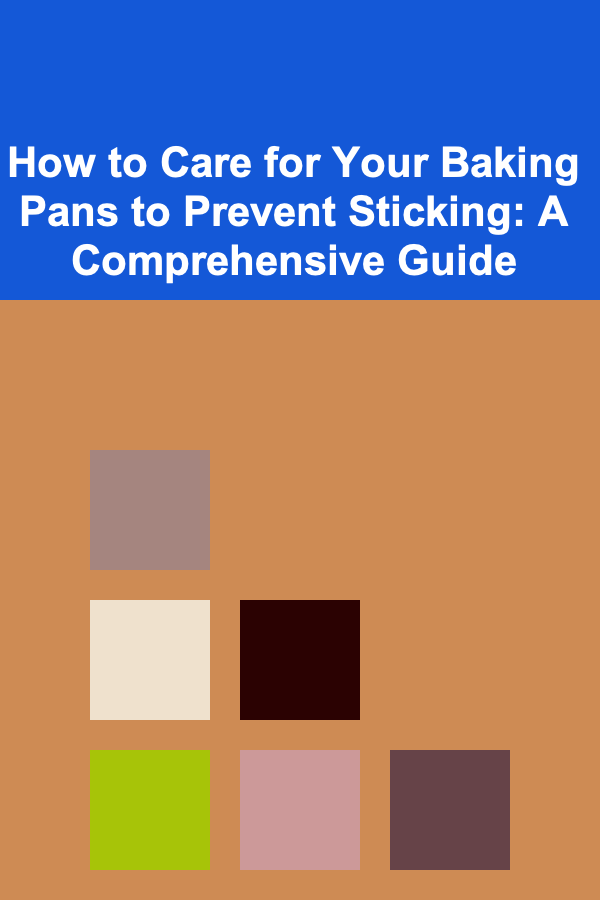
How to Care for Your Baking Pans to Prevent Sticking: A Comprehensive Guide
ebook include PDF & Audio bundle (Micro Guide)
$12.99$10.99
Limited Time Offer! Order within the next:

Baking can be a deeply rewarding experience, resulting in delectable cakes, golden-brown cookies, and perfectly crusted breads. However, the joy of baking can quickly turn sour when your creations stubbornly cling to the baking pan, leaving you with a crumbly mess instead of a beautifully presented dessert. Preventing sticking is not just about convenience; it's about preserving the texture, appearance, and overall enjoyment of your baked goods. This comprehensive guide delves into the art and science of caring for your baking pans to ensure consistently successful and satisfying results.
Understanding the Culprits: Why Do Baked Goods Stick?
Before we dive into solutions, it's crucial to understand the factors that contribute to sticking. Several culprits are often at play, and identifying them allows for a more targeted and effective approach to pan care.
1. Insufficient Greasing or Flour Coating
This is perhaps the most common reason for sticking. A thin or uneven layer of fat or flour provides an inadequate barrier between the batter and the pan's surface. The batter directly adheres to the metal, causing it to stick upon baking. The proteins in the batter coagulate and bond to the pan, creating a tenacious hold. Some recipes, particularly those with high sugar content, are especially prone to sticking due to caramelization. The sugar melts and hardens during baking, acting like glue and fusing the baked good to the pan.
2. Incorrect Pan Material
Different pan materials possess varying degrees of non-stick properties. Aluminum, while a good heat conductor, is generally more prone to sticking than non-stick coated pans or silicone bakeware. Glass bakeware, while aesthetically pleasing and easy to clean, can also cause sticking if not properly prepared. Cast iron, known for its excellent heat retention and even baking, can also cause sticking if not properly seasoned.
3. Overbaking
Overbaking can exacerbate sticking problems. As the baked good dries out, it shrinks slightly, which can strengthen the bond between the crust and the pan. The longer the baked good is exposed to high temperatures, the more likely it is to stick.
4. Improper Cooling
Allowing baked goods to cool completely in the pan can also contribute to sticking. As the item cools, it contracts, which can further adhere it to the pan. Certain recipes, like cheesecakes or delicate cakes, benefit from being cooled partially or entirely in the pan, but these recipes often require specific pan preparation techniques to avoid sticking.
5. Dirty or Damaged Pans
Residue from previous baking sessions, even if seemingly invisible, can create a sticky surface. Built-up grime, burnt-on food particles, or scratches on the pan's surface can all provide points of adhesion for the batter. Similarly, a damaged non-stick coating can lose its effectiveness and increase the likelihood of sticking.
The Arsenal of Solutions: Techniques for Preventing Sticking
Now that we understand the causes of sticking, let's explore the various techniques you can employ to ensure your baked goods release effortlessly from the pan.
1. The Classic: Greasing and Flouring
This tried-and-true method remains a reliable technique for many baking applications. However, the key lies in applying it correctly.
- Choosing the Right Fat: Butter, shortening, and oil are all viable options. Butter imparts a rich flavor, while shortening provides a more neutral taste. Oil, especially a neutral-tasting vegetable oil, is a good choice for light-colored cakes.
- Even Application: Use a pastry brush, paper towel, or your fingers to apply a thin, even layer of fat to the entire interior surface of the pan, including the bottom, sides, and any crevices or corners. Pay particular attention to areas where sticking is more likely, such as the bottom edges.
- Flouring Thoroughly: After greasing, sprinkle a generous amount of flour into the pan. Tilt and rotate the pan to coat all surfaces with a thin layer of flour. Tap out any excess flour to prevent a white, powdery residue on your baked goods.
- Alternative Flours: For darker cakes or brownies, consider using cocoa powder instead of flour to avoid a white film. For gluten-free baking, use a gluten-free flour blend.
Important Note: For intricate cake pans with decorative designs, greasing and flouring can be challenging. Consider using a baking spray or pan release (discussed below) for better coverage.
2. Baking Sprays: Convenience in a Can
Baking sprays offer a convenient and efficient alternative to traditional greasing and flouring. They typically consist of a blend of oil and flour in an aerosol form, providing excellent coverage and preventing sticking. Look for sprays specifically designed for baking, as they are formulated to withstand high temperatures.
- Proper Application: Hold the can about 6-8 inches away from the pan and spray evenly, ensuring complete coverage. Avoid spraying too much, as this can create a gummy residue.
- Types of Baking Sprays: Some baking sprays are specifically designed for specific types of baking, such as those containing cocoa powder for chocolate cakes or those with added lecithin for improved release.
- Cleanliness: Over time, baking spray can build up on pans, especially in corners and crevices. Clean your pans thoroughly after each use to prevent this buildup.
3. Pan Release: The Baker's Secret Weapon
Pan release, also known as cake goop, is a homemade or commercially prepared mixture that combines equal parts of flour, shortening, and oil. It provides superior release compared to greasing and flouring alone, particularly for delicate cakes and intricate pans.
- Homemade Pan Release: Combine equal parts of flour, shortening, and oil in a bowl. Mix well until smooth and creamy. Store in an airtight container in the refrigerator.
- Application: Apply a thin, even layer of pan release to the entire interior surface of the pan using a pastry brush or your fingers.
- Advantages: Pan release provides excellent release, prevents sticking, and creates a clean, smooth surface on your baked goods. It is particularly effective for cakes with a high sugar content or those that are prone to sticking.
4. Parchment Paper: A Versatile Solution
Parchment paper creates a physical barrier between the baked good and the pan, preventing sticking and making cleanup a breeze. It is especially useful for lining cake pans, baking sheets, and loaf pans.
- Lining Cake Pans: Cut a circle of parchment paper slightly larger than the bottom of the cake pan. Grease the pan, then place the parchment circle on the bottom. Grease the parchment circle as well. For the sides, cut strips of parchment paper and line the sides of the pan, overlapping the bottom circle slightly.
- Lining Baking Sheets: Simply place a sheet of parchment paper on the baking sheet before baking cookies or other items.
- Benefits: Parchment paper prevents sticking, simplifies cleanup, and can help prevent over-browning on the bottom of baked goods. It is especially useful for delicate cookies or cakes that are prone to sticking.
- Types of Parchment Paper: Both bleached and unbleached parchment paper are available. Unbleached parchment paper is more environmentally friendly, but both types work equally well.
5. Silicone Bakeware: Naturally Non-Stick
Silicone bakeware is inherently non-stick, making it an excellent choice for many baking applications. It is flexible, heat-resistant, and easy to clean. However, silicone bakeware can be less rigid than metal pans, so it is important to use it properly.
- Using Silicone Pans: Place silicone pans on a baking sheet for stability, especially when filled with batter. This makes it easier to transfer the pan to and from the oven.
- Greasing (Sometimes): While silicone is generally non-stick, some recipes may still benefit from a light greasing, especially those with high sugar content.
- Cleaning: Silicone bakeware is easy to clean with soap and water. Avoid using abrasive cleaners, as they can damage the surface.
- Limitations: Silicone pans may not brown baked goods as evenly as metal pans. Also, some silicone pans may have a slight odor, especially when new.
6. Seasoning Cast Iron: A Time-Honored Tradition
Seasoning cast iron bakeware creates a non-stick surface through polymerization. This process involves repeatedly coating the pan with a thin layer of oil and baking it at a high temperature, creating a durable and protective layer of baked-on oil.
- The Seasoning Process:
- Clean the pan thoroughly with soap and water. Dry completely.
- Apply a thin, even layer of oil (such as vegetable oil or flaxseed oil) to the entire interior and exterior of the pan.
- Wipe off any excess oil with a clean cloth.
- Bake the pan in a preheated oven at 350-400°F (175-200°C) for one hour.
- Let the pan cool completely in the oven.
- Repeat this process several times to build up a strong seasoning.
- Maintaining the Seasoning: After each use, clean the pan gently with a soft sponge and hot water. Dry immediately and apply a thin layer of oil.
- Benefits: A well-seasoned cast iron pan provides excellent heat retention, even baking, and a natural non-stick surface.
Beyond Preparation: Ongoing Care for Your Baking Pans
Preventing sticking is not solely about preparing the pan before baking. Proper cleaning and maintenance are crucial for preserving the non-stick properties of your pans and extending their lifespan.
1. Gentle Cleaning: Avoid Abrasive Cleaners
Abrasive cleaners, such as steel wool or scouring pads, can damage the surface of your baking pans, especially non-stick coatings. Use a soft sponge, warm water, and mild dish soap to clean your pans. Avoid harsh chemicals or abrasive powders.
2. Soak Stubborn Residue: Patience is Key
For stubborn residue, soak the pan in warm, soapy water for 15-30 minutes. This will help loosen the baked-on food particles, making them easier to remove. You can also try simmering water in the pan on the stovetop for a few minutes to loosen stubborn residue.
3. Proper Drying: Prevent Rust and Corrosion
After washing, dry your baking pans thoroughly to prevent rust and corrosion. You can air dry them in a dish rack or dry them with a clean towel. For cast iron pans, drying them in a warm oven can help prevent rust.
4. Avoid Metal Utensils: Protect Non-Stick Coatings
Metal utensils can scratch and damage non-stick coatings. Use wooden, silicone, or plastic utensils when working with non-stick pans to avoid damaging the surface.
5. Storage: Protect Your Investment
Store your baking pans properly to prevent scratches and damage. Stack them carefully, using pot protectors or parchment paper between them to prevent scratching. Avoid storing heavy items on top of your pans, as this can dent or warp them.
6. Re-seasoning: Reviving Cast Iron
Over time, the seasoning on cast iron pans can wear down. If your cast iron pan starts to stick, re-season it by following the seasoning process described earlier.
7. Recognizing and Addressing Damage: Knowing When to Replace
Even with the best care, baking pans eventually wear out. Non-stick coatings can become scratched or damaged, and metal pans can become warped or dented. If your baking pans are showing signs of significant wear and tear, it may be time to replace them. Using damaged pans can lead to uneven baking, sticking, and potential health hazards.
Troubleshooting Common Sticking Scenarios
Even with meticulous preparation, sticking can sometimes occur. Here are some troubleshooting tips for common sticking scenarios:
- Cake Sticks to the Bottom: Use parchment paper to line the bottom of the cake pan. Ensure the parchment paper is properly greased.
- Cake Sticks to the Sides: Grease and flour the sides of the cake pan thoroughly. Consider using pan release or baking spray.
- Cookies Stick to the Baking Sheet: Use parchment paper or a silicone baking mat to line the baking sheet.
- Muffins Stick to the Muffin Tin: Grease and flour the muffin tin thoroughly. Consider using paper liners.
- Brownies Stick to the Pan: Line the pan with parchment paper, leaving an overhang on the sides for easy lifting.
Conclusion: Mastering the Art of Non-Stick Baking
Preventing sticking is an essential skill for any baker. By understanding the factors that contribute to sticking and implementing the techniques outlined in this guide, you can ensure consistently successful and enjoyable baking experiences. Remember to choose the right pan material, prepare your pans properly, clean and maintain them diligently, and troubleshoot any sticking problems that may arise. With practice and attention to detail, you'll master the art of non-stick baking and create beautiful, delicious treats that release effortlessly from the pan.
Happy Baking!

How to Choose the Right Home Rental Property for Your Budget
Read More
How to Organize Your Closet and Keep It Tidy
Read More
How to Plan Seasonal Outdoor Activities for Family Fun
Read More
How to Prepare Effective Workshop Materials and Handouts
Read More
How to Store Yoga Mats and Accessories Neatly
Read More
Sales Executive Essentials: Techniques for Building Strong Client Relationships
Read MoreOther Products

How to Choose the Right Home Rental Property for Your Budget
Read More
How to Organize Your Closet and Keep It Tidy
Read More
How to Plan Seasonal Outdoor Activities for Family Fun
Read More
How to Prepare Effective Workshop Materials and Handouts
Read More
How to Store Yoga Mats and Accessories Neatly
Read More